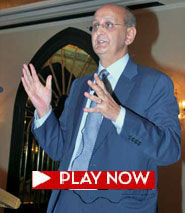
Rotarians gain insight into post-budget equity markets
Andrew Holland
Andrew Holland has led the Institutional Equities and Investment Advisory business at Ambit Capital since 2008. He currently leads the Investment Advisory business at Ambit Investment Advisors Private Limited as their CEO. Prior to joining Ambit Investment Advisors, he was the Managing Director – Strategic Investment Group for Merrill Lynch in India. He has also worked with County NatWest, Barclays and Credit Suisse.
He thanked the Club for inviting him and L&T Management for helping organise the event. He began by asking Rotarians how many of them are bearish and bullish investors in the stock market and went on to explain how it works for those unfamiliar with the bullish market in India. He said, “I would like to begin by explaining when we became bullish and why. In the months of June, July and August 2013, India experienced a currency crisis and Indian investors lost money everywhere. We, at L&T, made a presentation to our customers in October 2013 and explained to them why we thought 2014 would be a bullish market. If we look at the stock market from 2003 to 2007, the government was kick-starting the economy through infrastructure spending on roads, ports, power and manufacturing. If you ask anybody about the ‘big theme’ in the country during that period, they will say IT, which is correct. Information Technology led the Indian economy in those years. What we expected was that it was going to be a domestic driven economy. We knew that we were not going to see high growth rates and that the economy would not be making a jump to seven per cent from four and a half per cent but expected it to reach five and a half at the very least.
“When we did evaluations of the market in the areas of IT, farmer and consumer staples, the PE (price equity) of the broad market was approximately at 10, which is cheap by any standards.We believed that as India would start to accelerate its GDP, the investment focus would be towards the infrastructure industry, which would then have a multiplier effect on other industries and that is how we would start the bull market in 2014.”
Holland explained how L&T focussed on the domestic supply theme. He said, “In January 2014, we became bullish. Today, the government says they are going to spend 25 billion dollars building gas pipes around the country, but what concerns us is who is going to supply the infrastructure for it. Think about the economy and its early cycle, mid-cycle and late cycle. India is, thankfully, in the early cycle, but to lay the gas pipes, we have to first know who supplies to India, across all markets and where our money is going. Whenever we come to the end of the bullish market, investors will be in the defence sector or suppliers of service. So, in the next three to five years, the domestic supply theme will play across all sectors, market cycles and industries.”
He also explained why L&T predicted the fall in interest rates in 2014. “Given the global scenario, it was doable for the RBI to cut interest rates by 50 basis points in the first quarter of this year. We will see 300 basis points of interest rate falls over the next two years. This is what is going to happen because globally, we are in a currency war and everyone is exporting inflation.”
